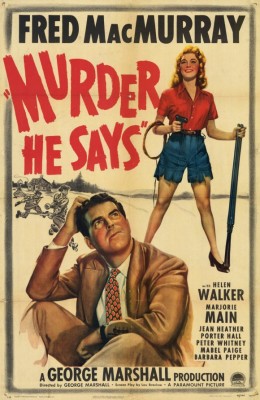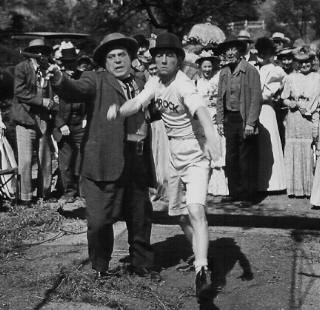| Reviews & Columns |
|
Reviews DVD TV on DVD Blu-ray 4K UHD International DVDs In Theaters Reviews by Studio Video Games Features Collector Series DVDs Easter Egg Database Interviews DVD Talk Radio Feature Articles Columns Anime Talk DVD Savant Horror DVDs The M.O.D. Squad Art House HD Talk Silent DVD
|
DVD Talk Forum |
|
|
| Resources |
|
DVD Price Search Customer Service #'s RCE Info Links |
|
Columns
|
|
|
Murder, He Says / Feudin', Fussin' and A-Fightin'
We weren't sent final product but rather two DVD-Rs. These included notes about the film, publicity photos and other extras associated with these TCM exclusives but it's not clear just how these will be sold. As DVD-Rs? A double-sided DVD-18s? Single-layer? We're hoping to get final product soon and, if we do, we'll update this review.
Murder, He Says is an odd genre hybrid, a mystery-comedy with horror-fantasy elements populated by hillbilly types. Fred MacMurray stars as Pete Marshall, a pollster from Trotter ("Same as the Gallup Poll, only we're not in so much of a hurry," he says) replacing another man that went missing after visiting the Fleagles, a crazy family of killer hillbillies. Pete meets Mamie Fleagle Smithers Johnson (Marjorie Main), the matriarch, who carries a bullwhip she frequently uses; her hulking adult twin sons, Mert and Bert (both played by Peter Whitney); third husband Mr. Johnson (Porter Hall), an eccentric and menacing inventor; Elany Fleagle (Jean Heather), Mamie's dimwitted daughter; and Grandma Fleagle (Mabel Paige).
It's soon obvious to Pete that the Fleagles have not only murdered his predecessor, but have also poisoned grandma (apparently after ingesting phosphorous; she glows in the dark like some hounds Mr. Johnson apparently had experimented with first). Grandma knows the whereabouts of $70,000 in stolen loot from an earlier bank robbery committed by granddaughter Bonnie. On her deathbed the old lady gives Pete a cross-stitched sampler with musical notes and strange lyrics ("Flizon horzis, Beezin komzis, Onches nobis, Inob keezis").
Claire Matthews (Helen Walker), trying to clear her father, who was falsely implicated in the robbery, shows up pretending to be Bonnie, and then later still Bonnie herself (Barbara Pepper) arrives looking for the money. The 91-minute film wears out its welcome before it's over, and anyone who remembers "Mairzy Doats" will be able to guess the location of the stolen cash.
Based on a story by Variety film critic Jack Moffitt, Murder, He Says was adapted by Lou Breslow, who wrote both straight mysteries (Charlie Chan, Mr. Moto), comedies (My Favorite Spy) and, with very mixed results, movies mixing both genres, notably A-Haunting We Will Go (1942), one of Laurel & Hardy's worst films.
Murder, He Says, however, is actually pretty clever, with a lot of funny dialogue, some nice comic bits - some probably worked out on-set by director George Marshall - and performances. For instance, when the dying, glowing grandmother hands Pete the sampler, he says, "Pardon me," and apologetically examines it using her phosphorus glow like a reading lamp. Later in the film, in trying to figure out the meaning of the sampler, there's a strange scene where Pete asks Claire, "Do you remember the Bob Hope picture The Ghost Breakers?" (another Paramount film) and then they virtually reenact that scene from the picture.
MacMurray excelled in roles like this; he effortlessly made the preposterous acceptable, probably the reason he later made so many Disney slapstick fantasies, and his comic timing is peerless. So good was he at this his considerable talent as a serious actor was often overlooked and tapped infrequently but memorably in films like Double Indemnity (1944, the same year this was made) and The Apartment (1960), both directed by Billy Wilder.
The movie is notable in a few unexpected ways. The split-screen photography used to get Peter Whitney's Mert and Bert together in the same shot is among the finest I've ever seen, and so natural most viewers probably assume real twins were cast. Porter Hall, usually the anal, minor-authority type with a chip on their shoulder (most famously in Miracle on 34th Street), has an unusual role here as Main's eccentric, deliriously murderous husband.
Barbara Pepper's appearance halfway through the film is also a bit of a surprise. A Joan Blondell-Iris Adrian type, back in the mid-1940s though not glamorous she was fairly pretty. Twenty years later, however, when she was still only 50 years old, Pepper had transformed into a grotesque: bloated, bug-eyed and prematurely aged - she looked about 70. For those who know her only as gregarious Doris Ziffel on Green Acres, she'll be almost unrecognizable. Most trace Pepper's decline to the tragic death of her husband in a motorcycle accident, which led to severe depression and a drinking problem that ruined her health.
Though a Paramount production while Feudin', Fussin' and A-Fightin' is Universal, there's a definite connection with its co-feature, however tenuous. MacMurray and Main would work together again (with top-billed Claudette Colbert and supporting player Percy Kilbride) in Universal-International's The Egg and I, released in the spring of 1947, which in turned launched the nine-film "Ma & Pa Kettle" series, starring Main and Kilbride, beginning with Ma and Pa Kettle, released in the spring of 1949. In between Main starred in two films in which she essentially played slight variations of Ma Kettle: the title role of The Wistful Widow of Wagon Gap (1947), an Abbott & Costello comedy (like the Kettle films Main had a brood of unruly children) - "It's 'Ma (Egg and I) Kettle' as the wild and willing widow" screamed the ads) - and Feudin', Fussin' and A-Fightin' (1948) where she was reunited with Percy Kilbride.
Just about any movie fan familiar with Universal-International's house style and their late-'40s comedies could probably write this one themselves. Feudin', Fussin' and A-Fightin' is a little like all of those earlier films - I suspect even some of the background plates for the rear-screen shots are leftovers from Wagon Gap - while also incorporating elements from another Universal commodity, star Donald O'Connor. Though best remembered today for MGM's Singin' in the Rain (1952), in fact O'Connor was a longtime Universal contractee, from 1942 through about 1955, appearing opposite fresh-faced ingénues like Gloria Jean and Peggy Ryan and, later, Francis the Talking Mule.
His performance in Feudin', Fussin' and A-Fightin' makes plain that Universal was holding back a major talent. In the film he performs what was his signature dance prior to "Make 'Em Laugh" in Singin' in the Rain: "Me and My Shadow," a tour de force performed with Louis DaPron, the latter seen only in silhouette. There are obvious antecedents to "Make 'Em Laugh" here (O'Connor running up the walls, doing flips, etc.) while in the film's comedy scenes, his body is impressively rubbery, like Ray Bolger on amphetamines. One can see why he might have seemed like a good choice to star in the later The Buster Keaton Story (1957). In the dance numbers O'Connor displays much the same grace, energy, and acrobatic skill of Gene Kelly - and it's all frittered away in a routine hillbilly comedy from B-studio Universal. No wonder he drank.
To say the least, the story is slight and its premise hard to swallow. Wilbur McMurtry (O'Connor) is a turn-of-the-century hair tonic salesman who arrives in the backwoods town of Rimrock just as its leaders are looking for a runner in their annual footrace against nearby Big Bend. When Wilbur misses his stagecoach and runs after it with amazing speed (O'Connor runs funny as well as fast), Mayor Maribel Matthews (Marjorie Main), stableman Billy Caswell (Percy Kilbride), and town sheriff Sharkey Dolan (Joe Besser) have Wilbur arrested on trumped-up charges and thrown into Caswell's stables for safekeeping until the big day. (Throughout the story, guarding him is I. Stanford Jolley, perennial bad guy in serials and Westerns.)
It's not a total loss as Wilbur quickly falls for Mayor Maribel's niece, Libby (Penny Edwards, here looking a lot like Barbara Eden). But word of the ringer eventually reaches Big Bend's leader, Chauncey (Harry Shannon) and he tries to sabotage the race with the help of Doc Overholt (Howland Chamberlin, the nosy hotel owner in High Noon).
Like Universal's other lowbrow comedies of the period, Feudin', Fussin' and A-Fightin's climatic foot race is an orgy of broad slapstick: tumblers, grumblers, bumblers, fumblers. If you're a fan of Abbott & Costello or Ma & Pa Kettle, you know what to expect. Unexpectedly, Joe Besser, later a riot on The Abbott & Costello TV show and later still one of the Three Stooges, is surprisingly subdued as Sheriff Dolan, affecting none of his "You crazy you-u-u-u-u!"/"Not so ha-a-a-a-r-d!" persona for which he is best known. In such a broad comedy, it's strange to see him essentially playing it straight.
Written by D.D. Beauchamp, whose work was also the basis for The Wistful Widow of Wagon Gap, the Wilbur character is also oddly conceived. Neither the pliable patsy nor quite the mild-mannered leading Fred MacMurray-type one might have expected, the resulting effect is that Wilbur comes off as ineffectual and mildly unappealing. He's smarter than his self-serving captors yet too stupid to simply leave.
Video & Audio
Murder, He Says looks okay though not pristine, about average or a little below for a mid-1940s big studio title. While most of Universal's '40s titles tend to look pristine on home video, Feudin', Fussin' and A-Fightin' is surprisingly worn, and the weaker of the two transfers. It looks like a really old master or derived from a second or even third-generation source, possibly a 16mm television syndication negative. Not that it's Alpha Video, straight-into-the-trash-can quality video-wise, but given Universal's usual standards it's definitely a disappointment. The mono audio is acceptable.
Extra Features
Supplements include solid text notes about each films (these are also on-line at TCM's website), along with publicity stills, poster and lobby card art.
Parting Thoughts
Neither is a lost classic, yet both films should please fans of this type and are mildly Recommended.
Stuart Galbraith IV's latest audio commentary, for AnimEigo's Musashi Miyamoto DVD boxed set, is on sale now.
|
| Popular Reviews |
| Sponsored Links |
|
|
| Sponsored Links |
|
|
| Release List | Reviews | Shop | Newsletter | Forum | DVD Giveaways | Blu-Ray | Advertise |
|
Copyright 2024 DVDTalk.com All Rights Reserved. Legal Info, Privacy Policy, Terms of Use,
Manage Preferences,
Your Privacy Choices | |||||||













